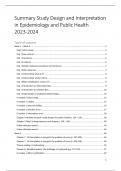Samenvatting
Summary Study Design and Interpretation in Epidemiology and Public Health
Summary Study Design and Interpretation in Epidemiology and Public Health HNH31006. Including notes of the 'refresh knowledge' clips, all the e-modules, lectures, studyclips and chapters of the Essential Epidemiology book. (Essential Epidemiology and instruction for students and health profes...
[Meer zien]





